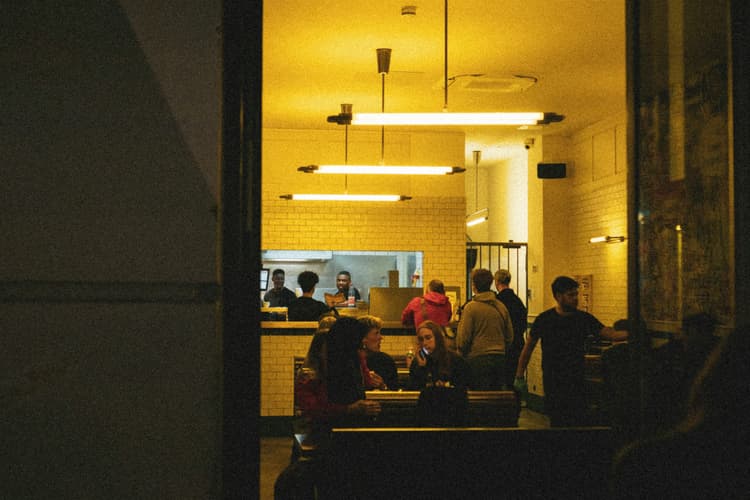The narrative around restaurant automation often paints a dystopian picture: robots replacing workers, technology eliminating jobs, and the slow death of human interaction in dining. But something very different is happening on the ground at restaurants across the country.
Rather than replacing workers wholesale, forward-thinking QSR operators are discovering that kiosk technology allows them to redeploy existing staff into roles that create more value for customers and more satisfaction for employees. It’s not a labor shortage—it’s a labor evolution.
Key Data Points:
- 70% of restaurant operators report having job openings that are tough to fill, while 45% say they don’t have enough employees to support existing customer demand
- Bars and eateries lost a net 25,500 jobs in Q1 2025—the lowest quarterly performance since late 2020
- More than 74% of operators expect wages to increase in 2025
- 68% of QSRs now use handheld devices for line-busting or table-side ordering
- 65% of operators are adopting new technologies like self-service kiosks, AI-powered drive-thrus, and labor-management systems
The Staffing Crisis Is Real
The numbers paint a stark picture of the restaurant labor shortage. Currently, 70% of restaurant operators report having job openings that are tough to fill, while 45% say they don’t have enough employees to support existing customer demand. This isn’t a temporary blip—it’s the new operational reality.
The situation worsened in early 2025. Bars and eateries lost a net 25,500 jobs in Q1 2025, marking the lowest quarterly performance since late 2020. Meanwhile, more than 74% of operators expect wages to increase in 2025, adding additional pressure to already thin margins.
For restaurants trying to deliver excellent service while managing rising costs and persistent staffing challenges, the traditional model simply isn’t working anymore. Something has to change.
Technology as a Strategic Response
Faced with these challenges, 65% of operators are adopting new technologies like self-service kiosks, AI-powered drive-thrus, and labor-management systems. But the most successful implementations aren’t about cutting headcount—they’re about reimagining how restaurants deploy their most valuable asset: human employees.
The key insight driving this shift is simple: not all tasks require human judgment, personality, and problem-solving skills. Taking routine orders at a counter is important work, but it doesn’t leverage the unique capabilities that human employees bring to restaurants. When technology handles these transactional tasks, people can focus on work that genuinely requires a human touch.
The Redeployment Revolution
Innovative restaurant operators are rethinking their entire service model around this principle. Iwona Alter, COO of The Habit Burger Grill, describes how they’re testing host positions where employees act as concierges for customers: “definitely a lot more texture and intimacy as to how the hospitality can happen in the restaurants today.”
This isn’t just feel-good rhetoric—it’s a fundamental reimagining of QSR staffing solutions. Instead of standing behind a counter processing routine orders as quickly as possible, employees can:
The Kiosk Ambassador Role That Provides Personalized Assistance
Some customers need help navigating menus, understanding options, or accommodating dietary restrictions. Others have questions about ingredients or want recommendations. When self-service kiosks handle straightforward orders, staff become available to provide this high-touch assistance to customers who need it most. At Bite, we call this role “Kiosk Ambassador.” It’s a simple way to redeploy your existing staff to drive kiosk adoption.
This creates a better experience for everyone. Tech-savvy customers who prefer to order independently can do so without waiting in line, while customers who value personal interaction receive more attentive service than they would in a traditional counter-order model.
Focus on Food Quality and Presentation
One of the most common redeployments involves moving staff from front-of-house order-taking to back-of-house food preparation and quality control. Additional hands in the kitchen mean faster ticket times, more consistent food quality, and better ability to handle customization requests accurately.
This operational shift addresses one of the biggest complaints customers have about fast-casual dining: inconsistent execution. When your team isn’t stretched thin trying to simultaneously take orders and prepare food during rush periods, quality improves across the board.
Enhance Cleanliness and Atmosphere
Restaurant cleanliness has always mattered, but post-pandemic, customer expectations around sanitation have intensified. Redeploying staff to focus on maintaining dining areas, cleaning tables quickly between customers, and ensuring bathrooms stay pristine creates visible value that customers notice and appreciate.
Similarly, having staff available to check on dining customers, refill drinks, or address issues promptly transforms the dining experience in ways that drive repeat visits and positive reviews.
Manage Complex Situations
Technology excels at handling routine transactions, but it can’t manage the unexpected situations that arise daily in restaurants. Upset customers, incorrect orders, equipment malfunctions, and unique requests all require human judgment and empathy.
When routine orders run through kiosks, staff have the bandwidth to address these situations properly rather than rushing through them while worrying about the growing line at the counter.
The Employee Experience Improves Too
Restaurant automation often triggers concerns about job satisfaction and employee morale, but the reality of thoughtful kiosk implementation is often the opposite. Many employees prefer roles that involve more customer interaction, problem-solving, and variety over the monotony of taking orders during eight-hour shifts.
Front-line restaurant workers consistently report that the most stressful part of their job is managing the pressure during peak periods when lines extend out the door and every customer interaction feels rushed. Kiosks alleviate this pressure by distributing the order-taking workload, creating a calmer work environment where employees can focus on doing their jobs well rather than just doing them fast.
This improved work experience has tangible benefits for operators struggling with turnover. When jobs become more engaging and less stressful, retention improves—reducing the costs and disruptions associated with constantly recruiting and training new staff.
Doing More with the Staff You Have
Perhaps the most compelling argument for kiosk adoption in the current labor market is simple: you can serve more customers with your existing team. When bottlenecks at the counter disappear, throughput increases without adding headcount.
Technology like Bite’s kiosk platform allows restaurants to handle peak-period volume that would otherwise require additional cashiers. During lunch rush, instead of customers waiting in a single line for multiple cashiers, they can immediately access any available kiosk and complete their order in a fraction of the time.
This increased throughput doesn’t just mean happier customers—it means more revenue generated by the same number of employees. In an industry where labor costs are rising and finding qualified workers remains difficult, this operational efficiency becomes a crucial competitive advantage.
The Strategic Shift
The restaurants thriving despite the labor shortage share a common approach: they view restaurant automation not as a replacement for human workers, but as a tool that amplifies what their existing team can accomplish.
This requires letting go of traditional assumptions about restaurant staffing. The optimal QSR operation in 2025 doesn’t look like the optimal operation from 2015. Customer expectations have evolved, technology capabilities have advanced, and labor market realities have fundamentally changed.
Forward-thinking operators are embracing this evolution. They’re eliminating the bottlenecks that frustrated customers and stressed employees. They’re creating new roles that leverage human strengths rather than fighting against human limitations. And they’re building more resilient operations that can deliver excellent service even when perfect staffing remains elusive.
Beyond the Binary Choice
The conversation around restaurant technology too often presents a false choice: either embrace automation and lose the human element, or resist technology and struggle with operational challenges. The operators successfully navigating today’s labor market reject this binary thinking.
They recognize that self-service kiosks and human hospitality aren’t opposing forces—they’re complementary elements of modern service delivery. Technology handles what technology does best, freeing humans to do what humans do best.
The result is restaurants that run more efficiently, employees who find their work more rewarding, and customers who receive better service across every interaction. That’s not a labor shortage being managed—it’s a labor evolution being embraced.
In a market where 68% of QSRs are already redeploying staff through technology, the question isn’t whether to adopt this approach. It’s whether you’ll lead this evolution or struggle to catch up while competitors pull ahead.





